
Catalog excerpts

Super Resolution Microscope N-SIM/N-STORM
Open the catalog to page 1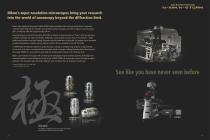
Super Resolution Microscope Nikon’s super-resolution microscopes bring your research into the world of nanoscopy beyond the diffraction limit. Nikon’s Super Resolution Microscope N-SIM/N-STORM enables elucidation of the structures and functions of nanoscopic machinery within living cells. The resolution of conventional optical microscopes, even with the highest numerical aperture optics, is limited by diffraction to approximately 200 nm. Using high-frequency structured illumination, the N-SIM can achieve an image resolution of 115 nm*, which was previously considered impossible with optical...
Open the catalog to page 2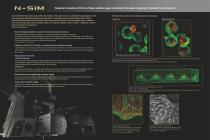
Temporal resolution of 0.6 sec/frame enables super-resolution time-lapse imaging of dynamic live cell events In structured illumination microscopy (SIM), the unknown cellular ultra-structure is elucidated by analyzing the moiré pattern produced when illuminating the specimen with a known high-frequency patterned illumination. Nikon’s Structured Illumination Microscope (N-SIM) realizes super resolution of up to 115 nm in multiple colors. In addition, it can continuously capture super-resolution images at a temporal resolution of 0.6 sec/frame*, enabling the study of dynamic interactions in...
Open the catalog to page 3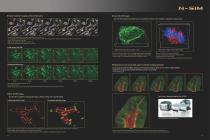
Super-resolution imaging of live cell dynamics Stack 3D-SIM images Stack 3D-SIM constructs 3D images based on Gustafsson’s theory, and is suitable for acquisition of volume data. Live-cell N-SIM imaging of mitochondria labeled with Mito-Tracker red. Live-cell imaging with N-SIM reveals dynamics of mitochondria at twice the spatial resolution. Cristae in mitochondria are also clearly observed. Mode: 3D-SIM mode (Slice 3D-SIM) Objective: CFI Apochromat TIRF 100x oil (NA 1.49) Image capturing interval: approximately 1 sec. (movie) N-SIM images (TIRF-SIM) Width: 26.19 µm, Height: 27.11 µm,...
Open the catalog to page 4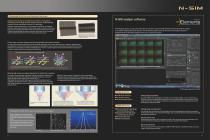
The principle of the Structured Illumination Microscopy N-SIM analysis software Analytical processing of recorded moiré patterns, produced by overlaying a known high spatial frequency pattern, mathematically restores the sub-resolution structure of a specimen. Utilization of high spatial frequency laser interference to illuminate sub-resolution structures within a specimen produces moiré fringes, which are captured. These moiré fringes include modulated information of the sub-resolution structure of the specimen. Through image processing, the unknown specimen information can be recovered to...
Open the catalog to page 5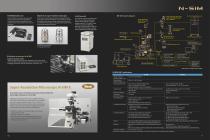
N-SIM illumination unit Objectives for super-resolution microscopes LU-NV laser unit This unit illuminates a specimen with a high spatial frequency pattern generated by a grating block and illuminates the specimen multiple times while shifting the phases and orientations of the structured illumination. The SR (super resolution) objectives have been designed to provide superb optical performance with Nikon’s super-resolution microscopes. The adjustment and inspection of lenses using wavefront aberration measurement have been applied to yield optical performances with the lowest possible...
Open the catalog to page 6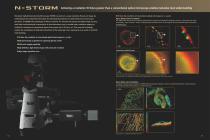
Achieving a resolution 10 times greater than a conventional optical microscope enables molecular level understanding STochastic Optical Reconstruction Microscopy (STORM) reconstructs a super-resolution fluorescent image by combining precise localization information for individual fluorophores in complex fluorescent microscope 10 times the resolution of conventional optical microscopes in x, y and z Up to 20nm lateral resolution specimens. N-STORM takes advantage of Nikon’s powerful Ti-E inverted microscope and applies high-accuracy, N-STORM utilizes high accuracy localization information...
Open the catalog to page 7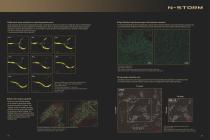
High-speed image acquisition for capturing dynamic events High definition, high density images with nanoscale resolution Image acquisition speed has been significantly improved, increasing from minutes to seconds* for a single shot, due to newly developed optics and illumination systems optimized for the sCMOS camera, which is capable of approximately 10 times faster image acquisition than before. Thanks to this improvement, it is now possible to acquire dynamics of living specimens at a resolution 10 times greater than that of conventional optical microscopes. The newly developed...
Open the catalog to page 8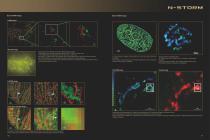
STORM images Wide-field image Frozen section of two-week-old mouse brain (Hippocampal CA1 region) STORM imaging and wide-field microscopy imaging for VGLUT1/PSD-95 in mouse neuron. Three STORM images are acquired with 3X zoom, 40X zoom, and 90X zoom Red: VGLUT1 Cy3-Alexa Fluor 647 (Pre-synapse), Green: PSD-95 Alexa Fluor 405-Alexa Fluor 647 (post-synapse) With STORM imaging, pre- and post-synapse structures are detected clearly and separately. Photos courtesy of: Naosuke Hoshina, Ph.D., Tadashi Yamamoto, Ph.D., Cell Signal Unit, Okinawa Institute of Science and Technology Graduate...
Open the catalog to page 9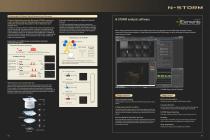
The principle of STochastic Optical Reconstruction Microscopy STochastic Optical Reconstruction Microscopy (STORM) reconstructs a super-resolution image by combining high-accuracy localization information of individual fluorophores in three dimensions and multiple colors N-STORM uses stochastic activation of relatively small numbers of fluorophores using very low-intensity light. This random stochastic “activation” of fluorophores allows temporal separation of individual molecules, enabling high precision Gaussian fitting of each fluorophore image in XY. By utilizing special 3D-STORM...
Open the catalog to page 10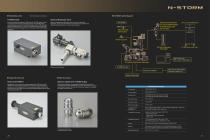
Illumination units N-STORM system diagram * Select one illumination unit alternatively. N-STORM module Motorized illumination unit M Based on the flexible and modular Ti-LAPP design, the N-STORM module is easily incorporated into the microscope illumination system. The N-STORM module automatically focuses the laser and adjusts the incident angle for TIRF illumination. Motorized magnifying lenses (1x, 2x, 4x) in the illuminator enable easy switching of illumination power and imaging field to accommodate various STORM imaging applications. Motorized illumination unit M provides control over...
Open the catalog to page 11All Nikon Instruments catalogs and technical brochures
-
Super Resolution Microscopes
28 Pages
-
HCA
8 Pages
-
DS-Fi3
16 Pages
-
ShuttlePix
8 Pages
-
A1 MP+ / A1R MP
15 Pages
-
A1 HD25 / A1R HD25
15 Pages
-
TI-E
32 Pages
-
ECLIPSE TS2
8 Pages
-
ECLIPSE TS2R
8 Pages
-
N-SIME
6 Pages
-
N-SIM N-STORM
24 Pages
-
ECLIPSE E100 LED
8 Pages
-
Bio Station IMQ
8 Pages
-
ECLIPSE Ti2
24 Pages
-
A1 MP+ / A1R MP+
20 Pages
-
DIGITAL SIGHT SERIES
16 Pages
-
Eclipse LV100N-POL Ci-POL
8 Pages
-
ShuttlePix Brochure
5 Pages
-
NeoScope Brochure
16 Pages
-
Eclipse FN1
12 Pages
-
Eclipse Ti
32 Pages
-
C2 Plus
16 Pages
-
A1+ / A1R+
13 Pages
-
Biological Microscopes
24 Pages
-
Stereomicroscopes
32 Pages
-
SMZ18
16 Pages
-
N-SIM E
4 Pages
-
A1_MP
11 Pages
-
AZ_C1
2 Pages
-
MiBrochure
2 Pages
-
A1+_A1R+_2CE-SBTH-9
13 Pages
-
C2+_2CE-SCHH-5
16 Pages
-
High Content Microscopy
2 Pages
-
NIS-Elements
8 Pages
-
Digital Sight Series
9 Pages
-
ShuttlePix P-400R
5 Pages
-
AZ100M
8 Pages
-
AZ100
4 Pages
-
Eclipse E200POL
3 Pages
-
Eclipse LV100ND POL/DS
2 Pages
-
Eclipse E100 LED
4 Pages
-
Eclipse Ci-E/ Ci-L
5 Pages
-
Eclipse Ni
15 Pages
-
Eclipse E200 POL
3 Pages
-
Biological Microscopes
12 Pages
-
ECLIPSE LV100N POL 50i/ POL
4 Pages
Archived catalogs
-
Digital Sight Series Brochure
16 Pages
-
Eclipse E100-LED
8 Pages
-
A1 MP+ / A1R MP+
11 Pages




















































